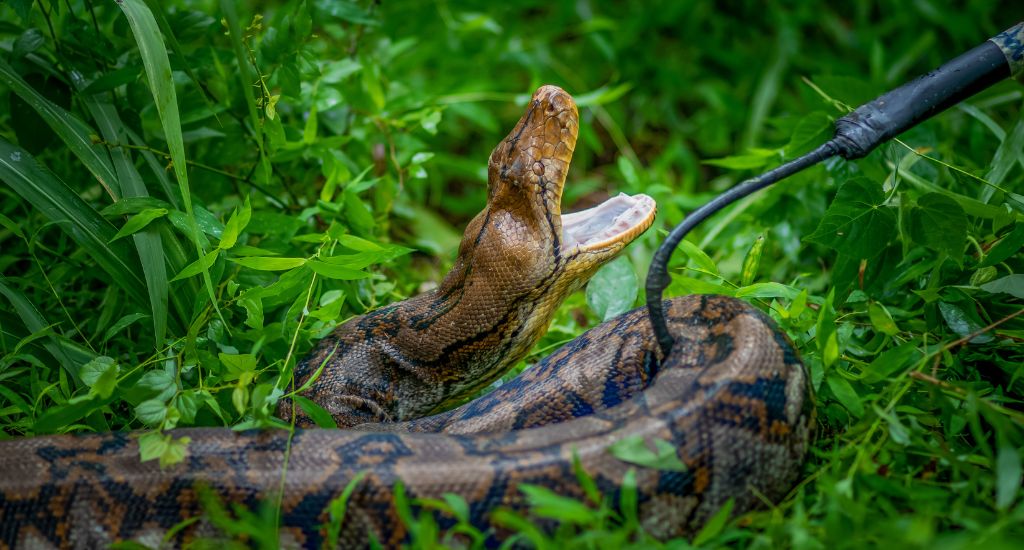
The fascinating story of a bank manager who caught snakes to save nature
If a snake is sighted in Gandhinagar, Pradip Khemchand Solanki is the go-to man – the self-trained serpent catcher who has rescued over 1,600 of the slithery beasts so far.

If a snake is sighted in Gandhinagar, Pradip Khemchand Solanki is the go-to man – the self-trained serpent catcher who has rescued over 1,600 of the slithery beasts so far.
It is 5 a.m. and Pradip Khemchand Solanki’s mobile phone rings continuously. It is another frantic SOS. This time it is from the home of former Gujarat education minister Bhupendrasinh Chudasama – urging Solanki to come and retrieve an unwanted guest. One that had slithered under the politician’s living room table.
The 58-year-old picks up his bag of tools and reaches the port-of-call quickly. For the next few hours he coaxes a large venomous cobra into a bottle to the great relief of the household. But his job is not done. He then hops back into his car and drives to the jungles outside of Gandhinagar where he lets his prey go free.

All before a day’s work.
Every experience of rescuing a snake has its high
For Solanki, the snake-catcher, is also a manager with Baroda Gujarat Gramin Bank.
What began as a childhood interest in serpents developed into the most unlikely of hobbies for Solanki who has been applying his reptilian knowledge helping keep humans safe from snakes. And vice versa. “Every experience of rescuing a snake has its high,” says Solanki.
He has rescued over 1,600 snakes, 800 of them from in and around Raj Bhavan and other buildings in Gandhinagar. His biggest catch was a cobra, six feet long. It had turned up at the gates of Sachivalaya, the government’s administrative office.
Solanki recalled coaxing the cobra out of a footpath hole. It was not easy because of the crowd. Traffic had come to a standstill and people were making videos and taking photographs from their cars.

Another unusual rescue was capturing a pair of mating Russell Vipers at a construction site. For the safety of the workers both had to be caught simultaneously, but the venomous couple was angry at being disturbed.
Also Read | Where the water monitor lizards have a free run
“Rat snakes, though not poisonous, are quite difficult to catch because they are fast and leave a foul smelling liquid. If anyone tries to catch them, they slide off easily,” he added.
The wonders of nature – snakes in particular – piqued Solanki’s interest early on when he was a kid.
“I would often go to Kankariya zoo in Ahmedabad just to observe snakes. Whenever snake charmers came to my neighbourhood, I would be in the front row watching in wide eyed wonder as the snakes would sway to the snake charmer’s been (wind instrument like a flute),” Solanki said.
But his childhood passion found wings in his early forties when he met Rasikbhai Patel, a snake and wild animal keeper at Indrorda Nature Park in Gandhinagar. He would accompany Patel on rescue missions and that’s how he learnt the ropes.
I’m there to serve the people – in the bank and outside of it,
Modern technology and tools have made catching snakes safe and relatively easy. These have reduced the chances of a snakebite.
The techniques may not have changed much, but when a snake is hiding under a carpet or inside a dark hole, a small camera rigged to a mobile phone gives away the location.

A snake-catching stick, a cloth back attached to an iron stick, a tong and a container with breathable holes to put the rescued snake are a must on every mission. The time taken to catch a snake depends on its location. It may take less than a minute or an hour.
Solanki’s skills as a volunteer snake catcher have spread by word of mouth and through articles on him published in newspapers. He has received awards and certificates from the chief minister, government departments and forest officials.
Also Read | Rural children in Tamil Nadu remain at risk from snakebites
His bank recognises his services and allows him to take off on rescue missions. “In Gandhinagar everything is close by and it does not take much time to catch a snake and get back to the bank. I’m there to serve the people – in the bank and outside of it,” Solanki said modestly.
Solanki taught his daughter Dhruvi to catch snakes when she was 13. She now accompanies him on most of his missions.

They both live by his motto: “save nature and nature saves you.”
They are fascinating and essential to ecosystems, because without them the number of prey species like rats would increase to unnatural levels and upset the natural balance.
Though people are still terrified of snakes, traditionally in India people worship snakes and even offer them milk at Naga Panchami, a festival which is observed on the fifth day of the waxing moon, normally in July/August.
But that’s not all. If a large number of snakes are killed, predators that eat those snakes would struggle to find food. But habitat destruction, hunting, and climate change are posing a great risk to snakes, according to a study published in the journal “Nature.”
Not surprisingly a rise in snake sightings has been reported in recent years in areas where the urban sprawl is eating into natural habitats. Solanki said he is catching more snakes each passing year because they come to urban areas in search of food—rats and other prey.
The photo at the top shows a big and ferocious snake being caught by hand (Photo by CoreRock, Shutterstock)
Usha Rai is a veteran journalist who has worked for the Times of India, Indian Express and Hindustan Times and mainstreamed development issues into news. She is recipient of the Chameli Devi award for outstanding women journalists.